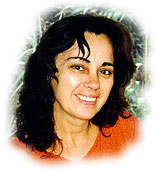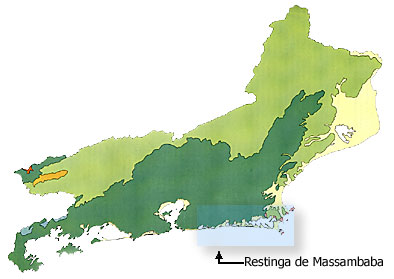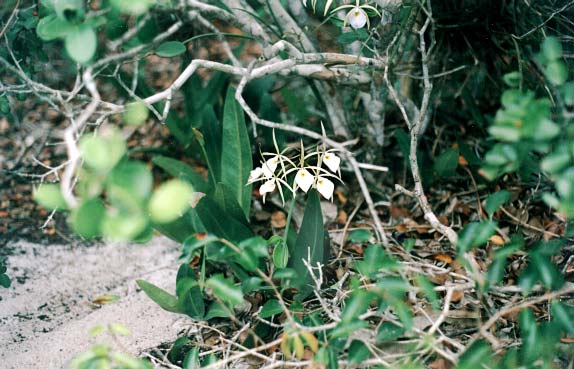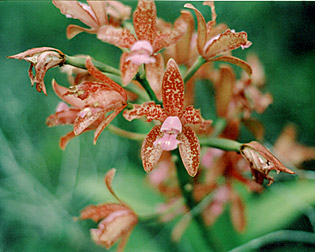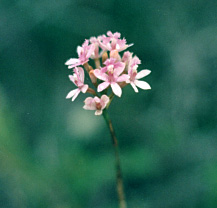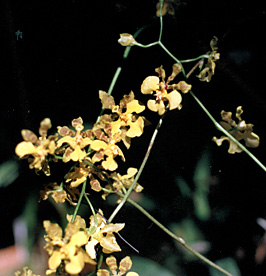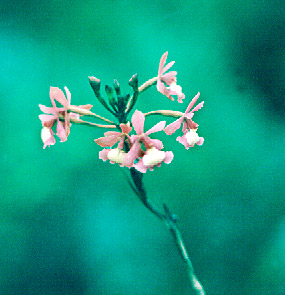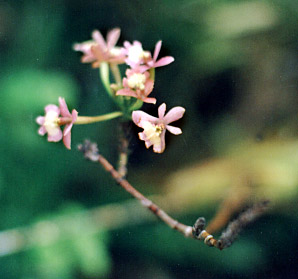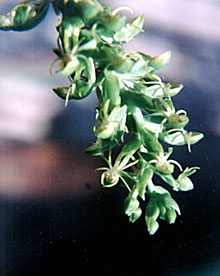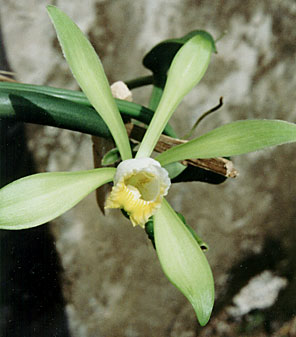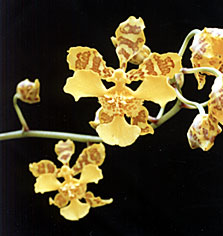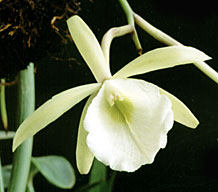According to the data researched by Maria da Penha Fagnani, it has been probably introduced by the cultivation and became a natural species. It is native to Central America although it appears in the specialized literature as occurring also in states of Alagoas, Amapá, Espírito Santo, Mato Grosso and Pará.
It blooms in May (Fall in south hemisphere).
The occurrence of Vanilla chamissonis Klotzsch has also been confirmed to the region, also occurring in the states of Bahia, Brasilia, Espírito Santo, Goiás, Minas Gerais, Mato Grosso, Pernambuco, Paraná, Rio de Janeiro, Santa Catarina and São Paulo.
Both occur in the two strips of sandy terrain (internal and external sandbanks).
The diversity of the habitats of orchids em our country is something amazing. The orchids occur in the Atlantic Forest, mountainous regions in general, in Amazon Forest, in the cerrado (woodland Savannah), in the outcrops and the restingas (Sandbanks).
We become more surprised when we realize the different genera that occur in those formations and their hard survival (not only concerning the Orchidaceae family but also the flora and fauna in general) due to the without controlled harvest and due to the aggressions arisen by the occupation of those areas although some of them are under the protection of the Governments as protected areas.
In the picture taken by Sylvio Rodrigues Pereira, in Massambamba restinga, in December l994 and April 2000, we can verify that, in spite of all kind of adversities, the orchids are still there; with their richness of coloration, with their capacity of adaptation in order to surviving in so hostile environment:
A
Massabamba, like every restinga (sandbank), does not present an homogenous area,
due to the diversity of the topography and the environmental conditions. It
has three kinds of soil. As a result, there is also a diversity of occurrence
of species in each one of those formations. A restinga presents two sandy cords
(internal - next to the lagoon, richer in orchids and an external - next to
the sea) where there is no retention of humidity and an area covered with a
dense organic material where grows the Bletia catenulata.This
kind of soil is so specified (a kind of peat) which makes the cultivation of
this species very difficult out of its habitat.
Everything
indicates that, in our state, this species only occurs in this region however
it is present in other states of the country such as Goiás, Minas Gerais,
Mato Grosso, Mato Grosso do Sul, Pará, São Paulo and Tocantins,
in general in cerrado region (woodland Savannah) in altitudes varying from 500
to 1.000m, in areas that are exposed to annual burning with a drought cold period
from May to September. So, very different from the habitat found in a restinga.
The plant type bears dark purple flowers.
In São Vicente, in the state of Mato Grosso, Lou Menezes verified the occurrence of a wonderful coerulea variety.
A Bletia catenulata Ruiz & Pavón blooms in Summer.
This
the case, between others, of Brassavola
tuberculata Hook (or Brassavola perrinii
Lindl.), sometimes growing as terrestrial, sometimes as epiphyte;
of
Cattleya guttata Lindl. growing as terrestrial
and presenting leaves similar to Cattleya intermerdia, hiding its roots
and squirming to send its spike in the searching of more luminosity or growing
in small trees, in dense vegetation, well protected from the direct sunbeams;
of
Epidendrum denticulatum Barb. Rodr. is
also present in many states of the country (Bahia, Minas Gerais, Pernambuco,
Paraná, Rio Grande do Sul, Santa Catarina, São Paulo and probably
also in other states not still mentioned);
of
Oncidium ciliatum
Lindl, present in almost all Brazilian coastal states from Alagoas and
also in Minas Gerais;
 back
back
and
of Epidendrum x ormindoi Miranda, with its color varieties.
A
Habenaria is one of the most abundant genera
of the country (at about 170 species in more than 800, occurring in all tropical
and sub-tropical regions of the world). This is a terrestrial plant that grows
well in muddy earth and even direct in marsh areas.
and
Habenaria repens Nutt.
(Habenaria taubertiana Cogn.),
that blooms in July (Winter in
South hemisphere).
Both
occur also in Atlantic Forest.
In cultivation, some species should be put in pots with little mud mixed with com humus. Some other, with vegetal detritus.
In
the restinga, two species occur: Habenaria parviflora Lindl., blooming
in spring and summer
Campylocentrum
is the only Brazilian "monopodial" (apical growing) genus. Brazil
has at about 32 species, Massambaba has two: Campylocentrum selowii Rolfe
and Campylocentrum robustum Cogn.
Campylocentrrum robustum Cogn. also occurs in Brasilia,
Espírito Santo, Minas Gerais, Mato Grosso do Sul, Pará, Paraná
and São Paulo. It blooms in Spring. Campylocentrum sellowii
(Rchb. f.) Rolfe , occurs in Alagoas, Mato Grosso Sul, Paraná, Rio Grande
do Sul, Santa Catarina and São Paulo. It blooms in summer.
This species occurs in well varied habitat at 1.000m altitude and also in marsh areas.
Both occur also in the Atlantic Forest.
The genus Epidendrum is represented by two species:
(Epidendrum denticulatum Barb. Rodr.
and
Epidendrum orchidiflorum (Salzm.) Lindl. (Epidendrum huebneri
Schltr.)
and
a natural hybrid: (Epidendrum x ormindoi Miranda).
All of them occurring in the internal sandy cord.
Prescottia,
another terrestrial genus with at about 17 species occurring in the country. It seems that just one occurs in that region, Prescottia oligantha (Sw.) Lindl. (ou Prescottia micrantha Lindl.)
This species also occurs in the states of Espírito Santo,
Minas Gerais, Paraná, Rio de Janeiro, Rio Grande do Sul, Santa Catarina
and São Paulo.
Between the three species of Vanilla considered as important to aromatize food (V. planifolia
Andr. , V. aromatica Sw. e V. trigonocarpa Hoehne) the only one found there is Vanilla planifolia Andr.
Encyclia
oncidioides (Lindl) Schltr, this is the only species of the genus found in this region, it blooms in summer and fall. It also occurs in the states of Alagoas, Amazonas, Amapá, Ceará, Distrito Federal, Espírito Santo, Minas Gerais, Paraíba, Pará, Pernambuco, Paraná, Rio Grande do Norte, Santa Catarina, Sergipe e São Paulo, in tropical forest and Atlantic Forest.
Oncidium
ciliatum Lindl. blooms in December (early Summer and south hemisphere) and also occurs in habitat completely different, as the mountains regions.
It grows in the states of Alagoas, Bahia, Ceará, Espírito Santo, Minas Gerais, Paraná, Rio Grande do Sul, Santa Catarina and São Paulo.
In cultivation, choose slabs of tree fern, in a humid hot or intermediate environment, with indirect light.
Former, Brassavola tuberculata Hook. and Brassavola perrini Lindl. were considered as two different species, but nowadays, Brassavola perrinii Lindl. is considered as synonymy and Brassavola tuberculata Hook. as a valid name.
However some researchers remain consider them as two different species.
In the sandbanks, it grows was epiphyte or terrestrial and blooms in April (Fall
in south hemisphere).
Catasetum
discolor Lindl, Cyrtopodium pollyphylum (Vell.) Pabst ex Fábio
Barros and
Epidendrum denticulatum were subjects of Orchid
News #13.
Two species of bifoliate Cattleya occur in the region Cattleya
intermedia Graham and Cattleya guttata Lindl.
Cattleya intermedia Graham also occurs in colder regions and in well diverse habitats. Nowadays, there are researchers that consider the possibility of having two different species. That which occurs in the sandbanks could be a different species from that occurring in the states of the south.
If we consider as just only species, it also occurs in the states of Paraná,
Rio Grande do Sul, Santa Catarina and São Paulo.
Plant considered as easy to cultivate in alive trees, stubs, pots com fiber of tree fern, barks, in high lighted environment.
A Cattleya guttata Lindl. blooms in fall in the restinga but in some other places, it occurs in winter.
In general, it has green petals and sepals with dark red-brown spots.
In this sandbank, it presents rose or vinaceous coloration.
It also occurs in the states of Alagoas, Bahia, Espírito Santo,
Minas Gerais, Pernambuco, Paraná, Rio Grande do Sul, Santa Catarina,
and São Paulo.
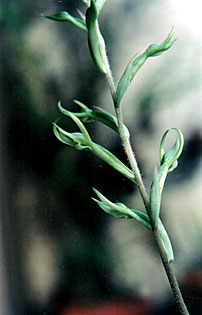
Eletroplectris
triloba (Lindl) Pabst, terrestrial plant, occurs in the interior of the thicket and blooms in June (later fall in south hemisphere).
The literature indicates occurrence in state of São Paulo and maybe in the state of Espírito Santo.
 continues
continues
